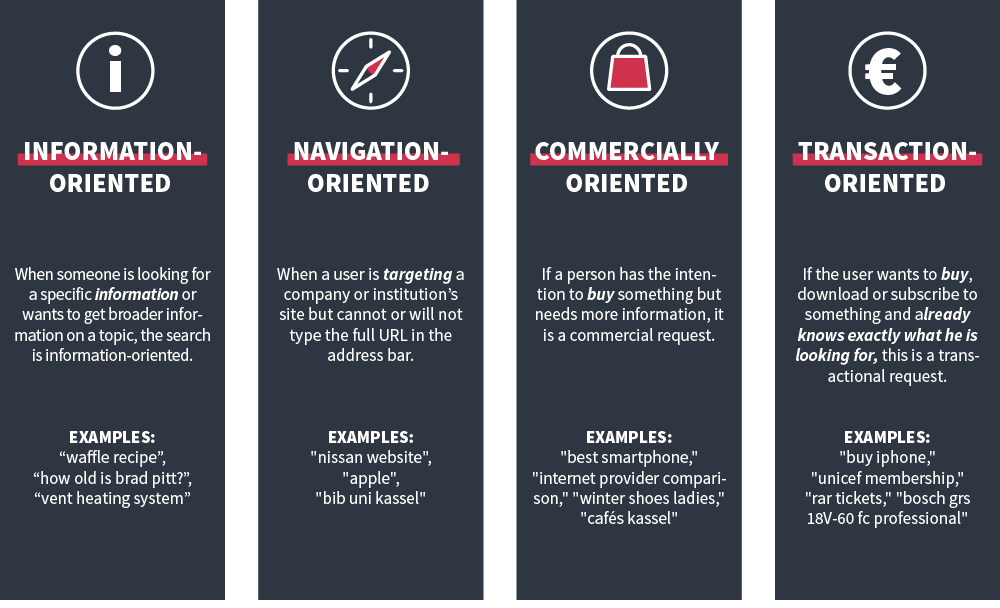
Our second part on the topic of search engine marketing deals with the area of search engine optimization, or SEO for short. As already discussed in the first part, search engines such as Google, Bing, Yahoo! and others are the first touchpoint when people search for information online. An important part of SEO work starts with the question of what the target group is actually looking for and, above all, how they search for it.
What is this article about?
To keep an overview, we have linked the most important terms to our search engine marketing cheat sheet.
Search engine optimization (SEO) is a subsection of search engine marketing (SEM) that ensures the visibility of a website in the organic, i.e. unpaid, search engine results pages (SERPs).
In addition to the familiar snippets of text, the search results pages can also contain snippets in the form of images, videos or news reports. Therefore, it makes sense to also consider Google Images, Google Video and Google News in search engine optimization. The fact that SEO marketers focus heavily on Google is due to the company’s market power. After all, more than two thirds of all search queries worldwide are made here and from mobile devices even 9 out of 10 search queries are made on Google.
The first 10 organic results are shown on page 1 of the SERPs on Google and are accordingly significantly more frequently clicked than results on subsequent pages. If your website is ranked on page 1 and number 1, it is almost 60% likely to be clicked. The second result only grabs barely 16%.
But who or what influences whether you end up on page 1 or page 20? The answer: the algorithm. Of course, we don’t claim to know the Google algorithm, but you can consider some measures that are also recommended by the search engine giant itself.
First of all, in order for your page to show up in the SERPs, it must be indexed by the crawler. – Excuse me? Simply put, let’s imagine the crawler as a robotic spider that searches the Internet for data (content). The spider loves order and likes to make its work easier. Every content for a certain search term, such as texts, images, videos, etc., is woven together by the spider and placed on its own list, the index, to make its work easier later. This way, it doesn’t have to search through all the data on the web again every time something new is added.
This means that if a page is to be displayed in the search results, it must be accessible to the crawler.
What measures can help the website of companies to appear in search results? Classically, SEO is divided into two areas – onpage and offpage SEO. While onpage measures are implemented directly on one’s own site, offpage measures concern external factors that affect the ranking and findability of a page.
The right keyword: It all depends on the search query
The magic begins with researching relevant search terms (keywords). But in addition to keyword research, search intent also plays a major role. The two are inseparable.
In general, four different types of search intent can be identified: information-oriented, navigation-oriented, commercial, and transaction-oriented.

Search engine optimization: infographic with 4 search types by user intention for SEO.
The commercial and transactional types are not always distinct. The intention is similar for both types. Many therefore also only assume three different search intentions. Google speaks of three different keyword types in this context:
Those who do search engine optimization always optimize first and foremost for the users, because what counts above all for the search engine providers is what the person in front of the screen wants. Therefore, you should pay enough attention to the keyword research at the beginning. All the following SEO work can stand or fall with this. It is worthwhile to question and check the keywords again and again later.
I know what you were looking for last summer …
Some products or services may be more seasonal or regional. “Barbecue charcoal” is searched for more frequently in spring and summer than in fall or winter, and “Semmeln” are more likely to be searched for in Bavaria, while “Schrippen” are better known in Berlin. So, there is a lot to consider when it comes to search engine optimization.
You have a website where the target group finds high-quality content? Great! Because that is already an important criterion for onpage optimization. Once the keywords have been found, it is important to place them in the right places. This includes title, description, meta tags, and headings, so that the snippet is ideally played out as desired.
Internal linking as well as image and video SEO are also part of the onpage area.
Marketers use the booster effect of film and video content
Film and video content has become a significant ranking factor for search engine optimization. This is one reason why more and more companies are opting to have content created in the form of a corporate film.
As the second largest search engine in the world based on traffic, YouTube has become the search engine for specialized content in B2B marketing after Google today. It is not uncommon for Google to show videos even before the Wikipedia entry in the results list, if the keyword is right.
We are happy to boost your content with you. Find out more about our services in the area of film and video.
Often, technical SEO is also counted among the onpage measures. Among other things, this involves optimizing the website for mobile devices and loading speed, using structured data for rich snippets and setting tags.
Offpage measures include strategies that influence the findability of the page without taking action on the page itself. This includes, above all, link building, i.e. the creation of external links that lead to one’s own page. If many relevant websites link to your own page, this is a sign of “authority” for the search engine, an important ranking factor.
Attention! Buying backlinks is not an option for search engine optimization. This method belongs to the so-called Black Hat SEO and is rightly punished.
Besides authority, expertise and trust are also among the three parameters found in the acronym E-A-T (expertise, authority, trustworthiness). These factors play a role in the human evaluation of pages, which should also be incorporated into the algorithm. Finally, Google is also interested in not spreading false news as far as possible and ranking high-quality content better.
The following measures can be counted as offpage SEO:
We have seen how important search engines are in online marketing. SEO is therefore an essential part of a good marketing mix. After all, you want your target group to find you where they are looking for products and services.
Companies that disregard search engine optimization not only lose traffic to their website, but also potential customers in the long term.
SEO is also measurable and cost-efficient. The implemented measures can be analyzed and successes measured. In this way, the investment can be evaluated and controlled with key figures. More visibility can also strengthen a company’s image and generate more sales in the long term.
Conclusion: Because no company can actually afford to be invisible, it should feed Google’s spider robot with SEO snippets. We are happy to help 😉